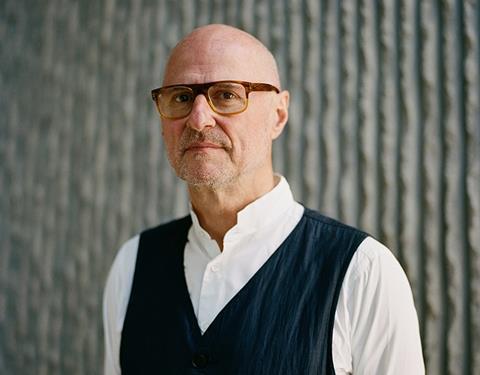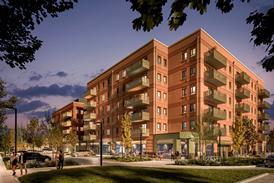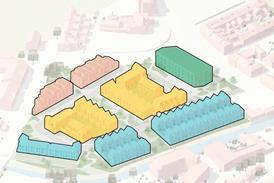Looking back over his two-year term, departing RIBA president Simon Allford argues that substantial change has been delivered and that the profession’s future is bright

Three years ago, I declared that “we should storm the building and take it back for architects and architecture”. And, when I arrived at the Royal Institute of British Architects (RIBA), architecture had indeed all but disappeared: council was consumed, the board blocked, and staff morale was understandably on the floor. Locked in a battle with intransigent forces within, it was failing.
As I step down as RIBA president, things are very different. Council is focused on the issues of the day and the board has stopped the financial rot. We have gone from losing close to £7m a year to approaching breaking even. We protected the proceeds of the NBS sale by placing them in an endowment, and are planning for the long term.
We have reduced our property footprint by selling 76 Portland Place for close to £12m and are now sharing RIBA North at Mann Island, Liverpool, in a creative partnership with the Tate. And we have a new CEO and staff leadership team.
I am looking forward to stepping down – but also to staying on board, literally and metaphorically, to help deliver the House of Architecture programme. In the short term, I will be on board for another year. For the longer term, I will have a role as a part of the client team that will be responsible, with our professional advisors, for the delivery of the House of Architecture – in physical and digital form.
I have every confidence that, with a fair wind in these difficult times, the new RIBA president Muyiwa Oki, alongside the council, chair, board and executive team, will keep things moving forward.
Architecture - the state of play
A reinvigorated profession is vital to the future of architecture, and a reinvigorated RIBA has a vital role to play.
Architecture is always under threat. Grenfell demands that we reform construction. The after-effects of Covid ricochet on, war in Ukraine threatens the peace, and economic instability has hit hard. Today, 38% of the world’s carbon dioxide emissions are the product of the built environment. So, as we adapt as a profession, we can have a hugely beneficial impact.
Reinvention and re-use will play a more important part, as recognised by a new RIBA reinvention award. We will also need to build new but build differently. Fifty years ago, former RIBA president Alex Gordon coined the mantra “long life, loose fit, low energy”. Today, above all else, we must design for longer life, for looser fit, and for lower carbon.
So, what for the profession?
Fifty years ago, Gordon spoke of a very different, self-governing profession, working in a world of fixed fees and public works. He also spoke of “RIBA’s petty internal squabbles” - plus ça change.
But, more importantly, he spoke of total design. Of value not cost. Of the need for good clients. And of architecture’s responsibility to society.
In those heady days of fixed fees, he chose the title “architecture for love or money” – a brave choice. For then, as now, the commercial drivers of architecture are too easily disregarded – and the profession pays the heavy price!
Yes, architecture drives us. But money fuels both that drive and its construction. Indeed, I know from experience that bad cashflow destroys creativity!
So, stronger finances of institute and profession are essential. They will make us more attractive to future generations. They will allow us to reverse our long retreat into an ever more confined role – exploited by others who are willing to take on the challenges that we consider too humdrum, too commercial even!
We must change. We must recognise that money is the constraint that can become the driver of architectural invention (and reinvention) – and of a more confident, capable and commercially respected profession.
I have often been told that a two-year presidential term is too short. I can assure you that two years is long and feels more than long enough!
The RIBA is an august institute with a long history of not quite achieving what it set out to do. Fundamentally changing how it operates, given its rules, regulations, new constitution, royal charter and charitable status has been like trying to change the course of a supertanker.
But, working together, we have done it. The organisation better understands its structure, with council keeping a watchful eye on the horizon, and focusing through its nimble expert advisory groups on the issues of the day.
I have often been told that a two-year presidential term is too short. I can assure you that two years is long and feels more than long enough!
Struggles aside, the RIBA’s structure now allows both long-term thinking and immediate action. The biennial action plan, which emerged from my campaign manifesto, has helped our longer-term focus on creating the House of Architecture at RIBA: rethinking our attitude to our collections, currently scattered in five locations; and reinventing both our permanent home, here at 66 Portland Place and its digital twin.
Since its inception in 1834, the RIBA has amassed one of the world’s greatest and most complete collections of 4.4 million architectural artefacts –including over one million drawings (of the 400 Palladio drawings known to exist, we have 380).
It is our defining asset – priceless and of huge value to the profession and society, and a vehicle to connect both. It represents the RIBA’s future as a cultural as well as a professional institute. It is no coincidence that the last two Royal Gold Medal winners both referenced our library and collection as a place and source of learning.
We have a great opportunity and responsibility, which is why we have put in place a sensible and achievable financial plan to look after the remarkable collection our predecessors bequeathed and make sure it also represents the best of today. Our collection will be made accessible to all, making RIBA an accessible global research centre.
66 Portland Place is RIBA’s forever home – well, almost, as we have but 910 years left on the lease!
We’re backing new models for architectural education
Our grade II* physical HQ is a great asset. But its current condition ill befits its role as home to the profession and our collection, as it is failing on sustainability and accessibility. We have a duty to discover and demonstrate what an exemplary net zero reinvention project looks like.
The House of Architecture establishes a reinvigorated RIBA as an outward-looking learned society and cultural institution. A generous host to discourse: a place where ideas about the design of our low carbon future are developed and shared – with members, partners, the public and government.
We have sold 76 Portland Place in order to bring staff, members and the public back to 66 Portland Place. We will soon be sharing RIBA North at Mann Island, Liverpool, in a creative partnership with the Tate.
Moving ahead, governance and process will be appropriately scrutinised, but not at the cost of architecture, operations or the sanity of those involved. We will invest in a proper IT platform to support sharing talks, debates and exhibitions online, driving professional and public engagement. This will develop further when, for the duration of the upgrade works, we vacate our HQ and make plans to go on the road.
We are working harder to support existing members and attract new ones. We are strengthening our Practice in a Box initiative, supporting single practitioners and small practices. We are working on a PII proposal that has the potential to address this major financial and operational challenge.
We are simplifying and enhancing our membership offer, creating a path from students to retirees that recognises a more fluid and dynamic profession. And, by engaging with those who do not practice but who care about architecture, we will build stronger connections with the public.
In education, as in practice, detail matters. We are backing new models for architectural education. While recognising the success of the classic degree and diploma route, we want to see a structure that allows students to qualify within five years. We are concerned that ARB’s accreditation model neither speeds things, nor allows new courses to emerge.
That said, ARB and The Department for Business and Trade have established new mutual recognition agreements that will help the next generation to study and work abroad, vital to the import and export of ideas. The architects of tomorrow will face challenges different from those of today’s curriculum.
This institute belongs to its members - and with their involvement, the re-modelled RIBA will be vital to designing a better future for everybody
Mies declared that “less is more” and at the RIBA we continually review what we can do well, and what is best left to the profession. We know that engagement with government on policy is a core activity that members value, and this is something that a “disinterested” RIBA can do better than an individual or practice.
So, we have rebuilt our policy and public affairs team. We employ a more engaged, critically intelligent voice to open doors to government at many levels, and we attend and host meetings with ministers of state on key government interests such as design codes, where we can influence the direction of travel. We are also now working within the Construction Leadership Council, which is itself close to government.
Our global awards programme has an important reach and sets the standard for studying architecture in use – how it performs for people and the environment. Our award of the Royal Gold Medal to Balkrishna Doshi and Yasmeen Lari presents our global perspective. Both architects remind us that architecture is about service to society over the long term.
On climate change, we are beyond declarations; now is the time for practical action. With our RIBA 2030 Climate Challenge embraced by the wider industry, we are leading partners in the next step – the launch of the Net Zero Carbon Buildings Standard.
We have invested time, money and intelligence in this vital pan-industry tool that will establish a standard for measuring embodied and operational energy and, crucially, create a potential data lake of predicted and actual performance – it has global potential.
Like all members, I am just passing through. I ended up here because I articulated my frustration. Past president Jack Pringle shared my concern, and together we have worked with the equally committed wider team of council, board, committee members and staff to establish the long-term plan that will enable the RIBA to move to the next level in fulfilling its membership’s needs and its charter commitment.
I would like to thank the RIBA membership for their support. This institute belongs to its members – and with their involvement, the re-modelled RIBA will be vital to designing a better future for everybody.
>> Also read: Simon Allford: ‘Architecture will emerge stronger’
Postscript
Simon Allford is RIBA President 2021-2023 and Executive Director, Head of Design Studio at AHMM.
















No comments yet